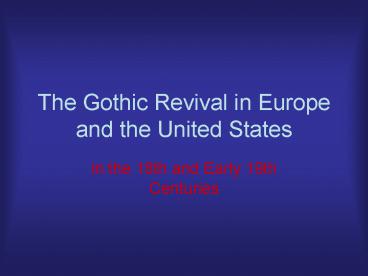The Gothic Revival in Europe and the United States - PowerPoint PPT Presentation
1 / 36
Title:
The Gothic Revival in Europe and the United States
Description:
... Dunstan's-in-the-East by Sir Christopher Wren, 1698 (damaged during World War II. St. Mary Aldermary, Victoria Street, by Sir Christopher Wren, 1682 ... – PowerPoint PPT presentation
Number of Views:432
Avg rating:3.0/5.0
Title: The Gothic Revival in Europe and the United States
1
The Gothic Revival in Europe and the United States
- in the 18th and Early 19th Centuries
2
Former Abbey Church at Zdar, Moravia Czech
Republic Renovation in the early 18th century by
Giovanni Santini Aichl View of the apse with its
gothic arcuation filled in. The gothic character
of the church was assimilated into the baroque
renovation.
3
Interior to East
Interior to West
4
Organ case in N transept
High Altar
5
Cemetery at Zelena Hora, Moravia Czech Republic
with Chapel by Giovanni Santini Aichl, early 18th
c
6
Views of the Circuit wall with corridor that
surrounds the cemetery
7
Principal (west) facade
Lateral (south) facade
8
Various views of the exterior,revealing the
idiosyncratic form.
9
High Altar with its sculptural decoration
10
Stucco respond and ribs
Vault and gallery
11
Window detail Organ Gallery (upper gallery)
12
Organ Gallery parapet detail (above back side)
13
(No Transcript)
14
The Gothic Revival in England
15
(No Transcript)
16
St. Dunstans-in-the-East by Sir Christopher
Wren, 1698 (damaged during World War II
17
St. Mary Aldermary, Victoria Street, by Sir
Christopher Wren, 1682
18
(No Transcript)
19
(No Transcript)
20
The reconstruction of some of the London churches
in Gothic style was a pragmatic choice that did
not have an immediate impact on British
architecture. However, in the middle of the 18th
century, Horace Walpole and a group of his
friends undertook an experiment that did have
consequences of great importance.
In 1748, at Twickenham on the banks of the Thames
above London, Horace Walpole erected a country
home that he named Strawberry Hill. This was a
conscious attempt to create a modern building
using the forms and ornaments of the Gothic. It
was also the first time that the Gothic had been
revived for residential or secular rather than
for religious buildings.
21
Strawberry Hill, Twickenham, by Horace Walpole
and others, 1748-77
22
Walpole assembled a variety of medieval elements,
none of them archaeological, and created an
asymmetrical composition with an irregular
roofline of towers, turrets, chimneys and
crenelations.
23
The gallery of Strawberry Hill is modeled on the
fan vaulting found in English Gothic cathedral
cloisters such as Lincoln and Gloucester. However,
these modern counterparts of the stone vaults of
the medieval period are executed in plaster. The
effect was more important than the technique.
24
Strawberry Hill was wildly popular. Tourists came
in droves from London to see and admire it. As a
result many other neo-Gothic works were built.
Sitting Room with fireplace derived from a
twin-towered façade, probably of a chapel or
church.
The Library with carved wood tracery derived from
a choir screen .
25
Library
Cabinet
26
Fonthill Abbey for William Beckford by James
Wyatt, 1796-1807
27
Fonthill Abbey by James Wyatt was one of the most
elaborate and extravagant of the neo-Gothic
houses. Meant to seem like an abandoned abbey
that had been taken over and inhabited by modern
people, it plays on the darker side of the Gothic
revival the mystical, mysterious, shadowy, and
awe-inspiring.
28
(No Transcript)
29
St. Michael Gallery
Plan
Grand Staircase
30
The interior was equally steeped in the sense of
the mysterious and even the foreboding. The
spiritual, aspiring forms of the medieval Gothic
now carried an element of the supernatural, the
ghostly, even the ghoulish, perhaps the magical.
31
The Gothic Revival in the United States
32
Cathedral of the Assumption, Baltimore, by
Benjamin Henry Latrobe, 1804-08
33
Two versions of the Cathedral of the Assumption
were designed by Latrobe one was neo-classic and
the other was gothic. The Church authorities saw
the neo-classic design as more suitable to
express the notion of religious freedom for which
Maryland had been founded by Lord Baltimore, a
catholic.
34
St. Marys Seminary Chapel, Baltimore, by
Maximilian Godefroy, 1806ff
35
Interior of the Chapel with modern choir stalls
and lighting. Note the plaster ribwork and the
decorative column clusters with gilded capitals.
36
(No Transcript)































